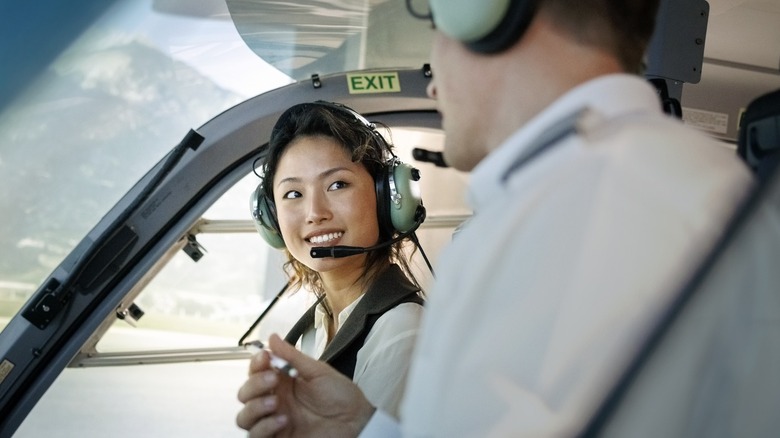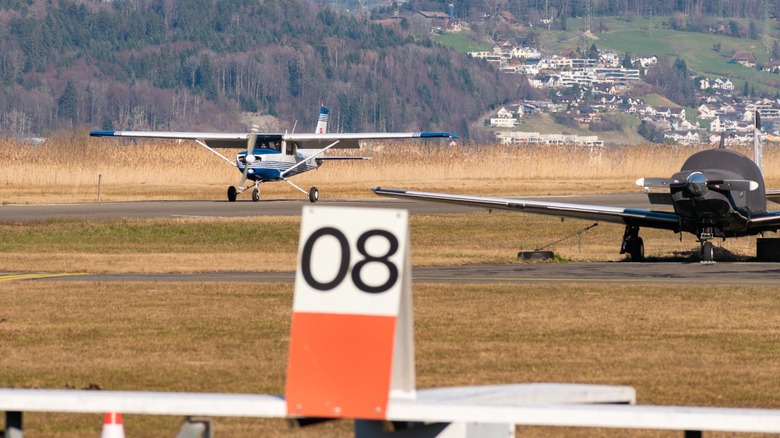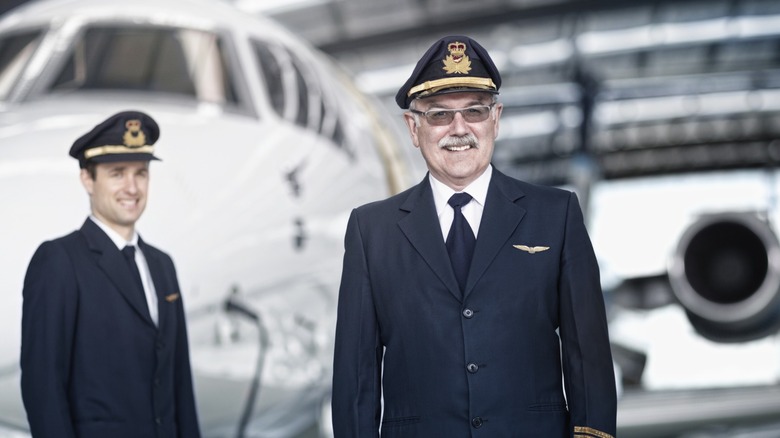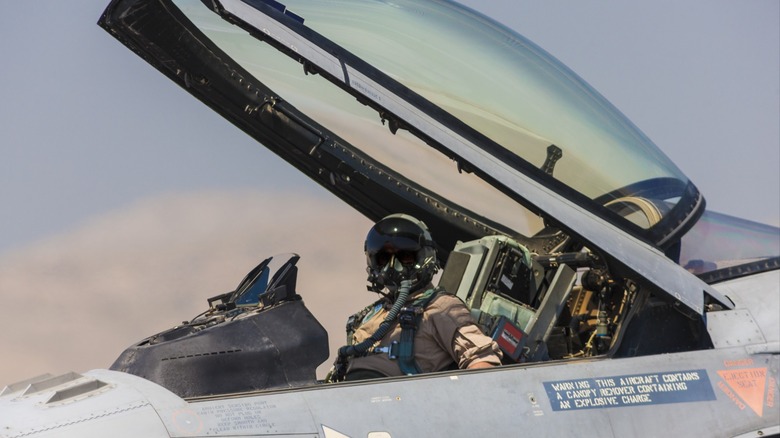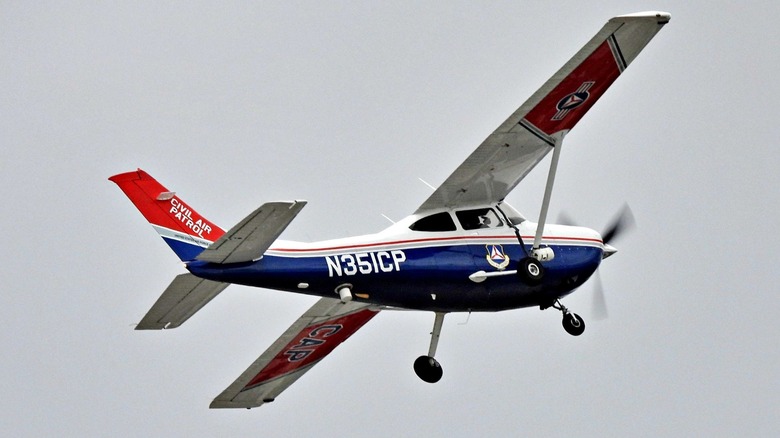5 Ways To Learn How To Fly An Airplane
Humanity has long dreamt about flying, and now that we can do it easily, many kids and adults still dream about becoming a pilot. While more accessible today than ever before, for many getting a pilot's license is still an arduous journey that will take many years and cost tens of thousands of dollars.
However, learning to fly an airplane may not be as difficult as it seems. Yes, it's true that you must learn a lot of theoretical knowledge in ground school — information that could save your life — and you will have to fly a few hours with an instructor to be qualified enough to take the practical test. Still, once you're used to flying, it could feel just as routine as driving a car.
The most common way for one to get a license is to go through a flying school, but that isn't the only way to do so. In fact, there are a few ways where you can learn how to fly without needing to spend a lot of money. So, if you know that you have what it takes to become a pilot, let's check out the few ways you can learn how to fly and get your pilot's license.
Enroll in a Part 141 flying school
The Federal Aviation Administration (FAA) is the regulatory body that's in charge of flying schools, whose operating principals are laid out in Title 14's Part 141 of the Code of Federal Regulations. This is where we get the term Part 141.
This regulations establish that any flight training institution that's certified under Part 141 must have a structure program and fixed training syllabus. You can equate a Part 141 pilot school as similar to colleges and universities that offer degree courses. In fact, many aviation-focused schools, colleges, and universities, like Embry-Riddle Aeronautical University, offer courses under Part 141.
Enrolling in a Part 141 flying school is a good solution if you're going to take up flying full time. For example, if you're going to college and want to get a degree in aviation while also learning how to fly, it's wise to go down this path. The FAA even has a dedicated page to help you find a Part 141 Pilot School — that way, you're sure that the school you're enrolling into is legitimate and that you're not wasting money.
Undergo Part 61 training
While learning how to fly as a full-time student in an academic institution is a great way to earn your wings, that isn't always possible for everyone. For example, you could have a career during the weekdays and only have time for training during the weekends. Perhaps you don't have enough money to pay for a full college degree, and you can only pay for training in installments.
While a Part 141 flying school means that it has been certified by the FAA, Part 61 training doesn't have as much direct oversight from the agency. Instead, Part 61 training could be done by any certified flight instructor who can adjust your lessons as they see fit. This makes it suitable for those who need flexibility, although going through Part 61 training often means getting your pilot's license will take much longer.
However, getting the training you need through Part 61 could be trickier, especially as you'll have to vet the training institution yourself if you choose Part 61 training. Nevertheless, some flying schools, like Wayman College of Aeronautics, offer both Part 141 and Part 61 training. That way, they can cater to both types of students, and you could feel a bit more confident regarding the quality of their instruction.
I would recommend Part 61 training if you're primarily getting a pilot's license for personal use and recreation. It's also the route that you should take if you want to buy one of the best planes for getting your private pilot's license and earn your wings on your personal bird.
Apply as an airline cadet pilot
If the main reason why you want to learn how to fly is to become an airline pilot, you can enroll in an airline cadet pilot course. These courses are often offered in partnership with airlines, like the American Airlines Cadet Academy or the AeroGuard Flight Training Center's Pilot Pathway Program in partnership with SkyWest Airlines.
You will have to pay for these training programs, with the American Airlines Cadet Academy costing between $95,000 and $105,000. However, the advantage here is that it would be much easier for you to score an interview with the partner airline after you complete your training. The training center would also be able to make you better equipped for airline operations, as it already knows what its airline partners are looking for in a pilot.
The AeroGuard program even has a detailed pathway, where after you get all your licenses and pass all the required exams, you will get hired by the school as an instructor. That way, you can get paid while you build the required hours to start working as an airline pilot.
Become a military pilot
It's true that learning how to fly is expensive, especially with the price of fuel, aircraft rental, instructor fees, and several other costs. That's why getting your wings is often out of reach of the average American, that is unless they have a lot of money stashed in the bank, have a sponsor such as a parent, or earn enough to be able to spend on training slowly but surely through Part 61 training.
Nevertheless, you could become a pilot by serving your country. In fact, you do not have to join the Air Force to become a pilot, as all branches of the military have aviation units — even the Coast Guard has one. However, to earn your wings in the armed forces, you must become an officer. This means signing up at the nearest recruit depot and passing the exams, going through basic training, and then attending the respective officer candidate school of the branch you joined.
This is one of the hardest routes to take if you want to learn how to fly, but it will always be an honor to be selected to serve as a pilot. Furthermore, if you get accepted in any military branch and was eventually able to get into flight training, you'll get paid to learn how to fly instead of the other way around. Of course, you'll have to serve a minimum number of years if you get trained in the military, with the US Air Force calling a minimum of 10 years active-duty status.
Join the Civil Air Patrol
If you're still a teenager or if you have kids who want to learn how to fly, you can start as early as now by signing for the Civil Air Patrol. The Civil Air Patrol is a federally chartered non-profit corporation that is also an auxiliary of the US Air Force. They're mostly made up of unpaid volunteers that offer emergency services, cadet programs, and aerospace education.
While you will not get your license in the Civil Air Patrol, you could get a start in a career in aviation within it by becoming a Civil Air Patrol Cadet. You will get to meet like-minded individuals who are interested in flying, but you will also get to meet passionate mentors who could guide you into a future career in the aviation industry. There are over 1,000 Civil Air Patrol hometown squadrons in the U.S., so you might be able to find one near you. If you do become an active member, you could eventually be able to start learning how to fly here.
There are many ways of becoming an aviator, so don't lose hope if you're not a pilot just yet. Whether you're just out of high school or already 20 years deep into your current career, you can always earn your wings and learn how to fly. And remember, you don't need to pay for your entire training in one giant lump sum. As one veteran pilot said about pilot training, you can start flying with simpler, more affordable aircraft.
